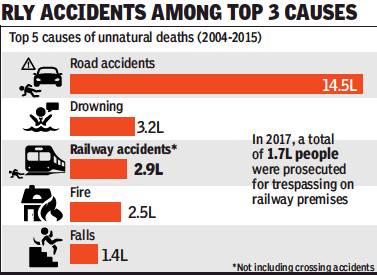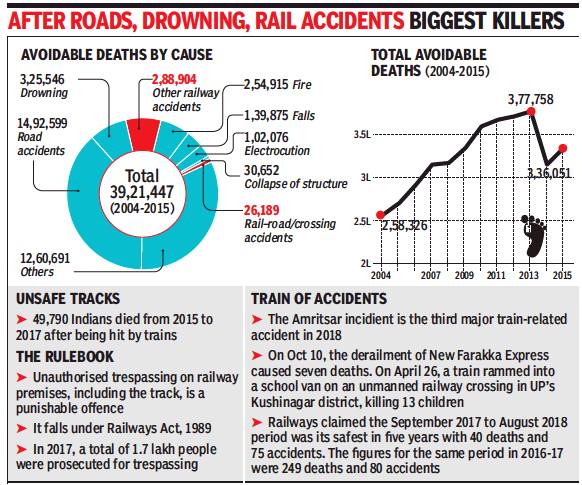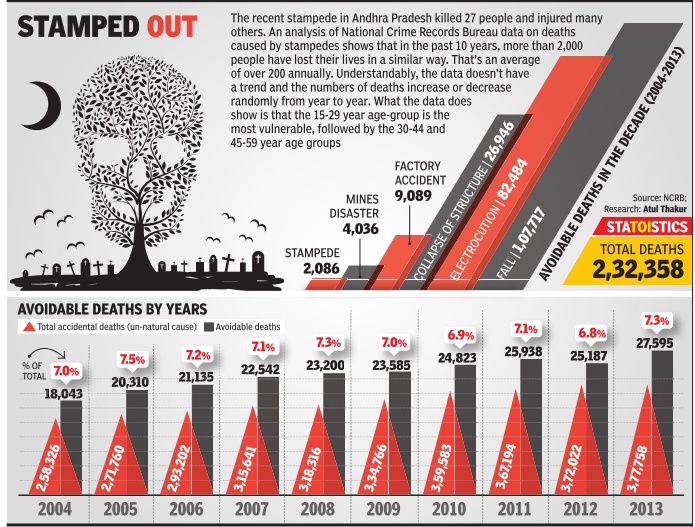Accidental, unnatural deaths and injuries: India
Contents |
2004-15, 17: unnatural deaths
October 21, 2018: The Times of India

From: Atul Thakur, 39 lakh deaths in last 12 yrs were avoidable: Govt data, October 21, 2018: The Times of India

From: October 21, 2018: The Times of India
While road and rail accidents contribute the chunk of avoidable deaths, incidents involving explosions and house collapse, mostly as a result of regulatory lapses at factories and in construction, too, account for a sizeable number of such casualties. Further, National Crime Record Bureau (NCRB) data for 2004-2015 shows that falls and electrocution were big killers. each claiming over 1 lakh lives during the 12-year period.
After roads, drowning is the second-largest killer, accounting for more than 3 lakh deaths between 2004-2015. While over 8,000 people were killed because their boat capsized, the remaining deaths were caused by people accidentally falling into water bodies. The data shows that like traffic accidents, cases of death by drowning also increased over the years.
In 2004, drowning caused over 21,000 deaths with figure increasing to about 30,000 for 2015. “It has been noticed that there are certain spots where drowning incidents are common. But because of various administrative issues very little can be done about these spots. For instance, the Bawana canal in outer Delhi has steep walls on both sides at several spots; a person who accidently falls into the canal will have little chance of climbing back. Because of administrative issues, very little can be done to rectify that”, said a senior official.
Railway tracks and crossings are deadly spots, too. Between 2004 and 2015, over 26,000 lives were lost in accidents at railway crossings alone. A senior IAS officer says that the removal of illegal structures that stand alongside railway tracks can significantly reduce the number of such deaths. However, these constructions prove difficult to remove because of political reasons. Other major causes of avoidable deaths are fire, falls and electrocution, each of which kills lakhs of people.
All accidents are avoidable, but the Amritsar tragedy would rank among the most avoidable ones. If only organisers of the event had appealed to the people to get off the railway tracks, instead of lauding them for being there. If only the train could have been stopped or slowed. If only the effigy was lit a few minutes later. Any of these could have saved 59 lives on Friday evening.
Ironically the count of avoidable deaths—classified as unnatural accidents by the National Crime Records Bureau (NCRB)—is very high in India.
Such accidents killed more than 39 lakh people between 2004 and 2015. Accidents at railway tracks and crossings alone caused over 26,000 deaths during the period, that’s six deaths a day.
Among deaths caused by unnatural accidents, road mishaps are the largest killer, claiming about 15 lakh lives during the 12-year period. In 2015 — the latest year for which data is available — about 1.5 lakh people were killed in road accidents, a figure 64% higher than road accident fatalities in 2004.
“Faulty traffic engineering and poor enforcement, awareness and regulation are to be blamed for many of these accidents”, said a senior IPS officer, who added that weather conditions and topography further contribute to making many spots accident prone. After roads, drowning is the second-largest killer, accounting for more than 3 lakh deaths between 2004-2015. Other major causes of avoidable deaths are fire, falls and electrocution, each of which kills lakhs of people.
2007-13

See graphic, 'Accidental deaths: 2004-13'
2013: an increase in accidental deaths
34% of accidental deaths take place on roads
Deeptiman Tiwary
The Times of India Jul 01 2014
More people died of accidental causes in 2013 than the previous one with men out-numbering women in all kinds of such casualties except `fire accidents'. The latest data from National Crime Records Bureau (NCRB) for 2013 shows that a total of 4,00,517 people died of accidental deaths in 2013, an increase of 1.4% over the previous year.
Road accidents continue to be the major cause of unnatural accidental deaths recording 34.3% of all deaths, followed by `sudden deaths' (7.8%), `drowning' (7.5%), `poisoning' (7.3%), `railway accidents' (7.2%) and `fire accidents' (5.5%).
In the last category , 65.7% of those killed were females, as compared to 34.3% males.
The data show that the rate of deaths per thousand vehicles has decreased from 1.4 in 2009 to 0.9 in 2013, but is highest in Bihar and Sikkim at 1.6 followed by West Bengal at 1.5.
2014
2014: Rail accidents
The Times of India, Jul 20 2015

Mahendra Singh
`Rail accidents killed 25,000 in 2014'
Over 25,000 people died and 3,882 were injured in railway accidents in 2014, a government report has said. The National Crime Records Bureau (NCRB) report said 28,360 cases of `railway accidents' were reported during the year, showing a decrease of 9.2% compared to 2013 (31,236 cases).
The majority of railway accidents (61.6%) were due to fall from trains or collision with people on the tracks (17,480 out of 28,360 cases), the report said.
Maharashtra reported the maximum such cases, accounting for 42.5% of total cases of fall from train or collision of trains with people. A railway official said most such cases were reported from suburban services in the state and that a campaign is being run to educate people not to cross the tracks.
A total of 469 cases of railway accidents occurred due to mechanical defects like poor design, rack faults, bridgetunnel aults. In Andhra Pradesh, 385 persons died in railway acci dents due to mechanical defects.
Sabotage by extremiststerroristsothers caused 13 and five railways accidents in MP and UP respectively that led to loss of 18 lives. It was found that around 60 accidents were reported due to fault of drivers that killed 67 people. Interestingly, most railway accidents (4,966 out of 28,360) were reported between 6am and 9am, accounting for 17.5% of the total.
2014: Accidents claim more lives than natural calamities
The Times of India,,Jul 21 2015

Deeptiman Tiwary
Human error a bigger killer in India than natural calamities
In 2014, over 3L lives lost in accidents
Over 15 times more people die in human error-induced (unnatural) accidents than natural calamities almost every year. Among the unnatural causes of accidents, drowning and accidental fire killed most people after road or rail accidents in 2014. Latest data from the National Crime Records Bureau (NCRB) shows that while 20,000 people died in natural calamities across the country in 2014, human error claimed 3,16,828 lives. While majority of these people (about 1.7 lakh) died in traffic accidents, drowning killed close to 30,000 people to become the second biggest killer. Accidental fire took the third spot claiming about 20,000 lives.
For the first time, the NCRB has segregated the `unnatural causes' data into two categories -one which involves hu man error and `other causes' involving incidents such as heart attack, death during pregnancy , animal attacks and hooch tragedies among others.In the `other' category , NCRB has recorded 1.15 lakh deaths.Earlier these data were part of unnatural causes'.
Human error-induced accidental deaths have been increasing every year registering a growth of over 22% in he past 10 years. If the `others' category -segregated his year -is added to this, he increase is of over 66% since 2004. The positive, however, is that deaths due to natural calamities have been contained to an average of 20,000 since 2004. In the past 10 years, deaths in this category ncreased by only 6%. Given hat the population during his period increased by over 14%, this is an achievement that successive governments can be proud of. It is in a way also a reflection of improving capability of disaster mitigation measures and response.
When adjusted to population growth, deaths due to natural calamities show a declining trend over the past 10 years. The opposite of human error-induced accidents.
According to the NCRB, the rate of accidental deaths (both natural and unnatural) -per 1 akh population -has grown from 25 in 2004 to 36 in 2014. Given that the rate of deaths in natural causes has been declining, it shows badly on human error deaths -primarily traffic accidents, drowning and fire. This points to both lack of public awareness and the government's failure to make such places safe for public.
